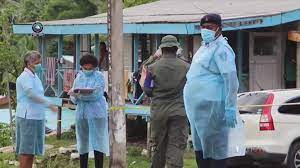The most pressing disaster facing the Pacific right now continues to be the COVID-19 pandemic.
And every place is different.
After closing its borders and aggressively vaccinating, Palau has recently recorded it first case.
While PNG has recorded more than 160 deaths and 16,000 cases, in Samoa, there has been only one case and no deaths, according to the World Health Organisation.
The first vaccines only arrived in the Polynesian nation a month ago and authorities were facing widespread vaccine hesitancy but, we can now report that more than 30,000 people – about 15 per cent of the population – has had at least one dose.
Director General of Health in Samoa Leausa Dr Take Naseri says the rollout programme is accelerating after a slow start.
“We have steadily progressed and now are seeing more and more people coming to be vaccinated,” he says.
“We know there are a lot of people from out in the rural villages that are coming to town just hoping to get a vaccine.”
Vaccination sites in central Apia and at the hospital are the busiest.
“The rollout is very encouraging,” Dr Maseri says.
“People are now fully aware – especially how this virus kills so many.”
Meanwhile, the outbreak of COVID-19 in the Pacific island countries and territories in 2020 led to many job losses, especially in the tourism and related industries, and triggered a slow down in overall economic activity.
This was highlighted in a report entitled “Changes in Consumer Prices in Selected Pacific Island Countries and Territories in 2020” which was released by the Pacific Community (S.P.C.).
The report reveals findings from more than 10 Pacific island countries and territories including Samoa.
According to the report, “many families saw a decline in their incomes necessitating recourse to a range of coping strategies.”
“The reports of the World Bank’s High Frequency Phone Monitoring Surveys of Households conducted in Papua New Guinea and Solomon Islands during the year throws further light on this,” reads the report.
The report also stated that with less to spend, consumer demand weakened.
“More and more people turned to, for example, growing food for their own consumption, sewing/mending their own clothes and forgoing personal activities such as going to the hairdresser, eating out, etc.
“Weakening demand led to a fall in the prices of various goods and services in many PICT This sends a clear signal of a slowdown in the economies of PICT.
“The average change in prices of products consumed by households (a fixed basket of goods and services typically bought by households in a country) in 2020 compared to 2019 shows that of the twenty PICT, twelve had inflation whilst eight had deflation i.e., their inflation rates fell below zero.”
Out of the 12 Pacific countries and territories that had price increases in 2020: six countries (Cook Islands, Kiribati, Niue, Northern Mariana Islands, Solomon Islands and Vanuatu) paid more for goods and services they bought in 2020 than they paid in 2019.
Five countries (Guam, Nauru, Papua New Guinea, Tokelau and Tuvalu) had disinflation. Palau’s inflation rate stood still as compared to 2019.
And out of the eight Pacific countries and territories, American Samoa, Federated States of Micronesia, Fiji, New Caledonia, French Polynesia, Samoa, Tonga and Wallis & Futuna experienced deflation.
Fiji recorded the highest rate of deflation at 2.6 per cent followed by Samoa at 1.6 per cent. A peek at Fiji’s data from 1979 shows that this is the first time Fiji has experienced an annual rate of deflation.
With slowing economic activity and weakening demand the appearance of deflationary trends in post-COVID-19 in PICT was to be expected. In 2021 unemployment will continue to be high and demand weak.
SOURCE: ABC/SAMOA OBSERVER/PACNEWS














